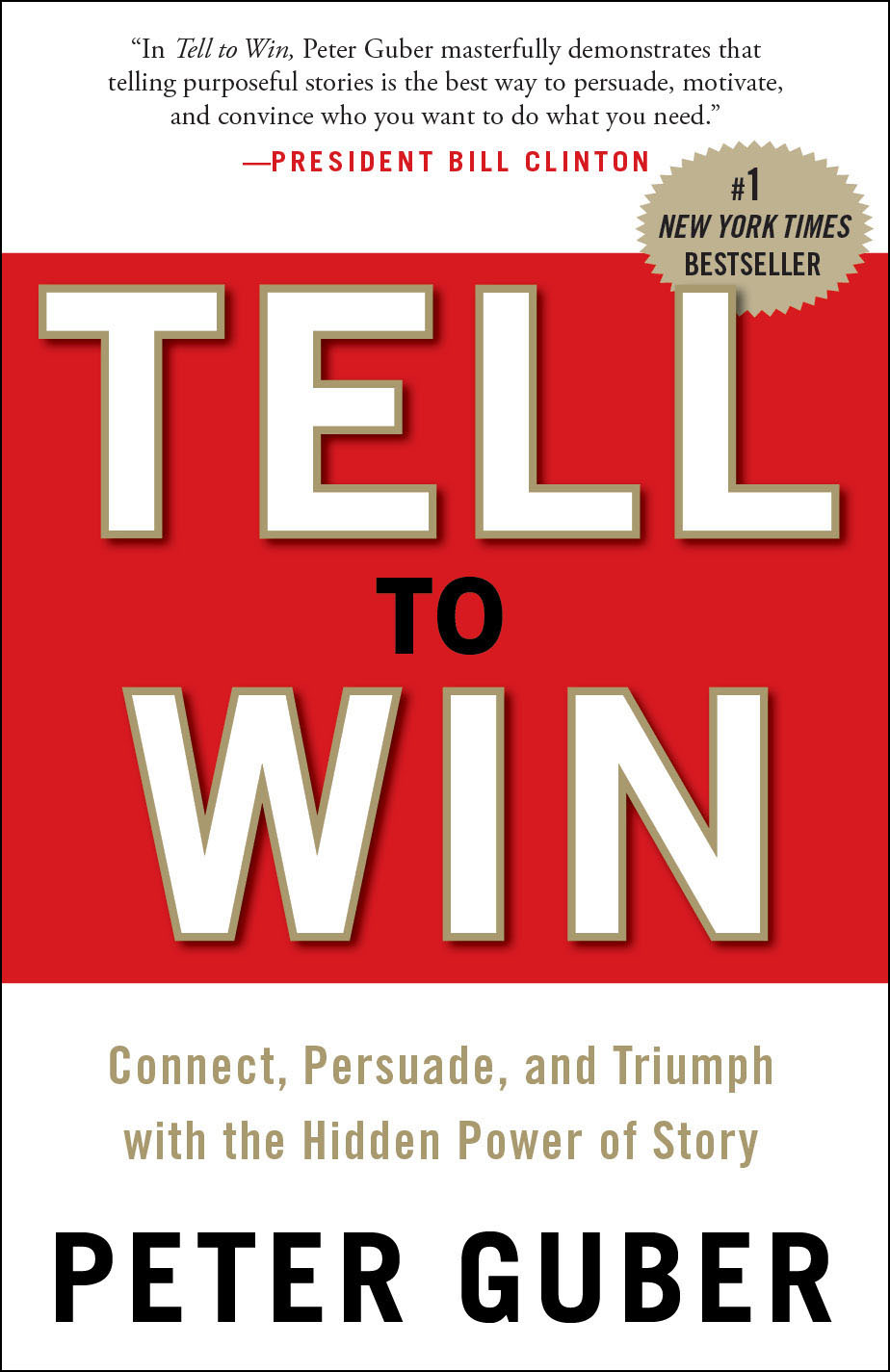Business needs more storytelling evangelists.
They provide a counter balance to the “Corporate Drivel-ites.”
Even before picking up the book “Tell to Win,” I’m thinking that Peter Guber serving as the face for the storytelling movement is a good thing.
He’s got the street cred, having penned “The Four Truths of Storytelling” for Harvard Business Review in 2007 (more on this later).
Plus, no offense to Steve Denning, the high priest of institutional storytelling, but Peter Guber brings celebrity and a certain “je ne sais quoi” to the cause.
I mean, this is the guy who produced “Rain Man” and goosed Dustin Hoffman’s career.
 Such a bias I took into reviewing his book.
Such a bias I took into reviewing his book.
As you would expect, Peter knows how to tell a story.
We learn that then presidential candidate Bill Clinton used the movie “High Noon” as a backdrop to tin cup for $90K to keep his campaign alive after losing the New Hampshire primary.
We learn Famous Amos liked the cookie business better than the agent business.
We learn Peter went on the movie set to tell Dean Martin to shape up only to have Frank Sinatra intervene with a “Who the hell are you?” before physically pushing him out the door.
Does the book teach business people how to apply storytelling in their jobs?
It’s a good starting point.
Before going further, keep in mind that Peter focuses on oral storytelling.
If you need to win someone over to your way of thinking, don’t get on the phone or send an e-mail or draft a 140-character plea on Twitter.
Get face-to-face with the person (or people).
Arianna Huffington, cofounder of The Huffington Post and now part of the AOL gang, affirms his belief:
“The more time we spend in front of screens, the more we crave human interaction. I believe the intimate in-person interactions where we tell stories to realize our ambitions, goals and dreams will only intensify as technology expands.”
With this as the backdrop, I found three takeaways that frame the book.
First, recognize that emotions play just as an important role as intellect in how people make decisions.
Stories – not facts, figures and spreadsheets – tap the heart.
This concept can be difficult to grasp for those coming from technical orientations who worship the tangible.
Two, the book explains the importance of personalizing your story with a hero.
There’s simplicity in the definition of a hero that comes from basketball coach and executive Pat Riley:
“In every story there’s one person who can make the difference. That’s your hero.”
And three, storytelling offers a means to show vulnerability, a quality for building trust.
According to Keith Ferrazzi, author of “Never Eat Alone” and one of Guber’s resources:
“Vulnerability is one of the most underappreciated assets in business today. Everyone has something in common with every other person. And you don’t find those similarities if you don’t open up and expose your interests and concerns, allowing others to do likewise.”
Putting the double negative aside, it’s an excellent point.
For those who favor their geek side, the book tackles the cognitive part of storytelling as well.
I especially liked the line from Jerome Bruner, a cognitive psychologist:
“Narrative emerges from violations to expectations.”
Peter’s buddy and neuroscientist Dan Siegel explains:
“You have expectations in your head; I have expectations in my head. We sit down to breakfast. I tell you, ‘I got up this morning, I went to the bathroom and picked up my toothbrush and put toothpaste on it, blah, blah, blah.’ Our expectations are totally in sync. There’s no violation of them. It’s boring. It’s not memorable.”
Allow me to simplify the equation.
Violation = Attention.
There were a couple parts in the book that didn’t work for me.
The inconsistency in one particular story rubbed me the wrong way. Peter’s quest to film in the waters of Havana Harbor hit a standstill until Fidel Castro set eyes on Miss Universe, Shawn Weatherly.
I’ll let Peter pick up the story in the book from here:
“But then he [Fidel] noticed something else. Shawn was holding a tooth as big as her hand, which had come from a 250-foot prehistoric great shark called a megalodon. This creature was some ten times larger than any shark living today, and its tooth clearly interested the president, so Shawn handed it to him. I seized on this serendipity to reset my story into a tale of the megalodon.”
Yet, the same story in Peter’s essay for Harvard Business Review depicts the tooth handover differently:
“As I spoke, I watched Castro toy with the equipment and listen with growing interest to the story of Havana harbor’s past. Finally, breaking the bureaucrat’s rule, I presented the Cuban leader with a giant tooth (seven inches long, five inches wide) from a megalodon, a prehistoric shark that had once prowled Havana’s waters.”
Also, I could have done without the pop psychology lesson; i.e., Larry King stayed at CNN because Ted Turner knew King put loyalty above money due to his father’s premature death which King interpreted as disloyalty.
Still, these aren’t major flaws.
All in all, I liked the book as well as the idea of Mr. Guber bringing greater attention to the storytelling movement.
As long as the reader doesn’t expect “Tell To Win” to be a magic wand transforming one into part Steve Jobs, part Ken Burns, we’re good.





Comments
Twitter Trackbacks for Storytelling Techniques For Effective Business Communications » Book Review: Entertainment Value Of “Tell To Win” Sugarcoats Lessons In Storytelling [ishmaelscorner.com] on Topsy.com
[…] Storytelling Techniques For Effective Business Communications » Book Review: Entertainment Value Of… ishmaelscorner.com/2011/02/14/entertainment-value…n-sugarcoats-lessons-in-storytelling-techniques/ – view page – cached The Art Of Storytelling In Business Communications And Public Relations […]
Business communications review
[…] Storytelling Techniques For Effective Business Communications … Feb 14, 2011 … Storytelling Techniques For Effective Business Communications В» Book Review: Entertainment Value Of… … […]